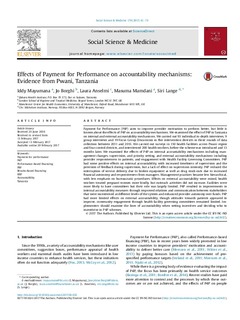Effects of Payment for Performance on accountability mechanisms: Evidence from Pwani, Tanzania
Journal article, Peer reviewed
Permanent lenke
http://hdl.handle.net/11250/2475333Utgivelsesdato
2017-01-01Metadata
Vis full innførselSamlinger
- Publications [1488]
Sammendrag
Payment for Performance (P4P) aims to improve provider motivation to perform better, but little is known about the effects of P4P on accountability mechanisms. We examined the effect of P4P in Tanzania on internal and external accountability mechanisms. We carried out 93 individual in-depth interviews, 9 group interviews and 19 Focus Group Discussions in five intervention districts in three rounds of data collection between 2011 and 2013. We carried out surveys in 150 health facilities across Pwani region and four control districts, and interviewed 200 health workers, before the scheme was introduced and 13 months later. We examined the effects of P4P on internal accountability mechanisms including management changes, supervision, and priority setting, and external accountability mechanisms including provider responsiveness to patients, and engagement with Health Facility Governing Committees. P4P had some positive effects on internal accountability, with increased timeliness of supervision and the provision of feedback during supervision, but a lack of effect on supervision intensity. P4P reduced the interruption of service delivery due to broken equipment as well as drug stock-outs due to increased financial autonomy and responsiveness from managers. Management practices became less hierarchical, with less emphasis on bureaucratic procedures. Effects on external accountability were mixed, health workers treated pregnant women more kindly, but outreach activities did not increase. Facilities were more likely to have committees but their role was largely limited. P4P resulted in improvements in internal accountability measures through improved relations and communication between stakeholders that were incentivised at different levels of the system and enhanced provider autonomy over funds. P4P had more limited effects on external accountability, though attitudes towards patients appeared to improve, community engagement through health facility governing committees
Serie
Social Science & Medicine vol. 179Social Science & Medicine vol. 179
